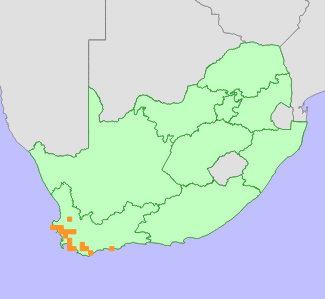|
Scientific Name | Moraea tricolor Andrews |
Higher Classification | Monocotyledons |
Family | IRIDACEAE |
Synonyms | Iris fugax Pers., Moraea barbigera Salisb., Moraea ciliata (L.f.) Ker Gawl. var. barbigera (Salisb.) Baker, Moraea ciliata (L.f.) Ker Gawl. var. tricolor (Andrews) Baker, Moraea duthieana L.Bolus |
National Status |
Status and Criteria | Endangered B2ab(iii) |
Assessment Date | 2011/03/16 |
Assessor(s) | J.C. Manning, P. Goldblatt, D. Raimondo & L. von Staden |
Justification | EOO 27 772 km², AOO estimated to be less than 500 km² due to extensive habitat loss and fragmentation. Between six and 12 severely fragmented subpopulations remain yet continue to decline due to ongoing habitat loss to crop cultivation, urban expansion and alien plant invasion. |
Distribution |
Endemism | South African endemic |
Provincial distribution | Western Cape |
Range | Citrusdal to Caledon, and eastwards to Stilbaai. Extinct on the Cape Flats. |
Habitat and Ecology |
Major system | Terrestrial |
Major habitats | Saldanha Granite Strandveld, Swartland Shale Renosterveld, Central Ruens Shale Renosterveld, Western Ruens Shale Renosterveld, Swartland Granite Renosterveld, Swartland Alluvium Renosterveld, Greyton Shale Fynbos, Elim Ferricrete Fynbos, Hangklip Sand Fynbos, Hopefield Sand Fynbos, Lourensford Alluvium Fynbos, Swartland Alluvium Fynbos, Hartenbos Dune Thicket |
Description | Seasonally moist depressions on sandy or clay flats. At Stilbaai plants occur in well-drained sand among coastal dunes. |
Threats |
| Habitat loss to wheat cultivation has caused significant population declines in the past, and continues to be a potential threat to some remaining subpopulations. Habitat loss to urban expansion as well as crop cultivation has caused the local extinction of this species on the Cape Flats. Urban expansion is an ongoing threat to subpopulations at Langebaan, Gouda and Stilbaai. Invasive alien plants as well as the effects of habitat fragmentation and degradation are threatening most known remaining subpopulations. |
Population |
A formerly widespread and very common species of the Cape Lowlands, the population has been severely reduced by extensive habitat loss. In 2006 there appeared to be only four remaining subpopulations, however, recent observations have significantly expanded the known range, and the number of confirmed extant subpopulations increasing to six. A further six subpopulations known from historical records are suspected to still be extant, as intact habitat remains in the areas where they were collected, but their existence needs to be confirmed. All known remaining subpopulations are extremely isolated, and the population is considered severely fragmented. This species continues to decline due to ongoing habitat loss and degradation.
|
Population trend | Decreasing |
Conservation |
| Elandsberg Private Nature Reserve. |
Notes |
| Recent observations have significantly extended the known range of this species, see Goldblatt and Manning (2009) and Goldblatt and Manning (2010). |
Assessment History |
Taxon assessed |
Status and Criteria |
Citation/Red List version | | Moraea tricolor Andrews | EN B1ab(i,ii,iii,iv,v) | Raimondo et al. (2009) | |
Bibliography |
Goldblatt, P. 1986. The Moraeas of Southern Africa: a systematic monograph of the genus in South Africa, Lesotho, Swaziland, Transkei, Botswana, Namibia, and Zimbabwe. Annals of Kirstenbosch Botanic Gardens 14:1-224. National Botanic Gardens in association with the Missouri Botanical Garden, USA, Cape Town.
Goldblatt, P. and Manning, J.C. 2000. Cape Plants: A conspectus of the Cape Flora of South Africa. Strelitzia 9. National Botanical Institute, Cape Town.
Goldblatt, P. and Manning, J.C. 2009. New species of Moraea (Iridaceae: Iridoideae), with range extensions and miscellaneous notes for southern African species. Bothalia 39(1):1-10.
Goldblatt, P. and Manning, J.C. 2010. Moraea intermedia and Moraea vuvuzela (Iridaceae-Iridoideae), two new species fro western South Africa, and some nomenclatural changes and range extensions in the genus. Bothalia 40(2):147-153.
Manning, J., Goldblatt, P. and Snijman, D. 2002. The color encyclopedia of Cape bulbs. Timber Press, Portland/Cambridge.
Raimondo, D., von Staden, L., Foden, W., Victor, J.E., Helme, N.A., Turner, R.C., Kamundi, D.A. and Manyama, P.A. 2009. Red List of South African Plants. Strelitzia 25. South African National Biodiversity Institute, Pretoria.
|
Citation |
| Manning, J.C., Goldblatt, P., Raimondo, D. & von Staden, L. 2011. Moraea tricolor Andrews. National Assessment: Red List of South African Plants version . Accessed on 2025/05/18 |
 Comment on this assessment
Comment on this assessment


